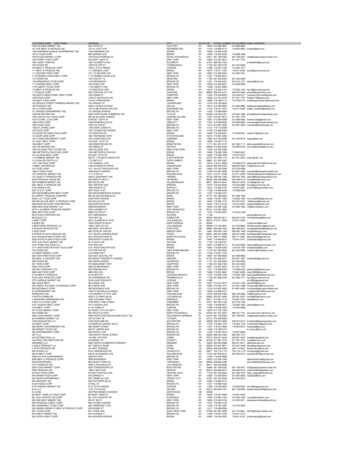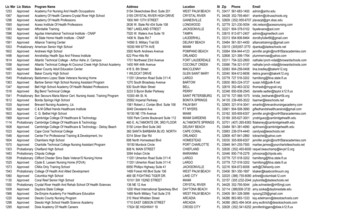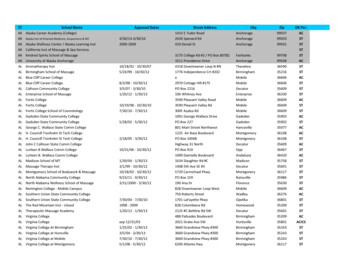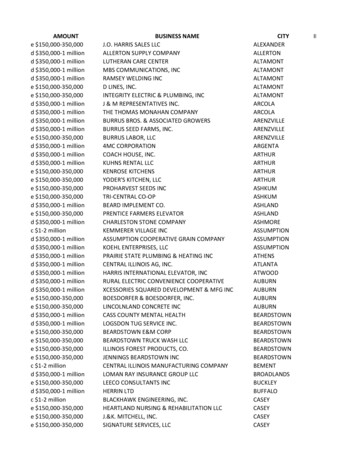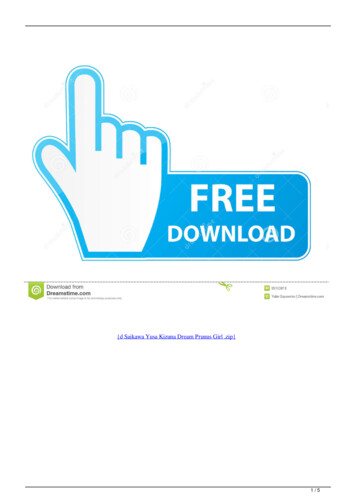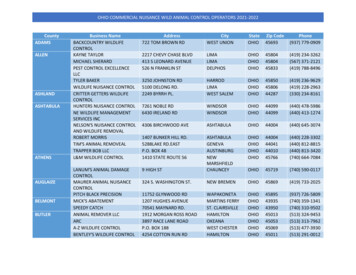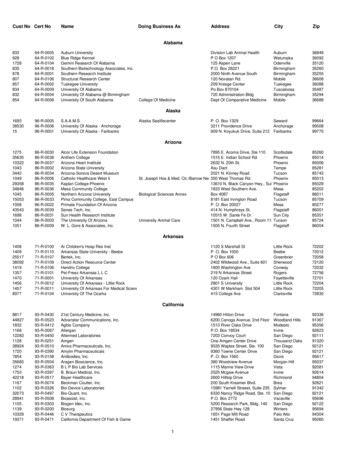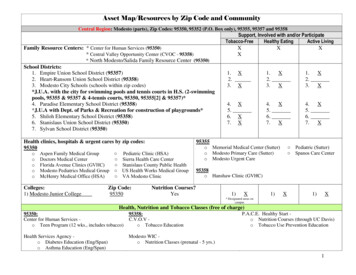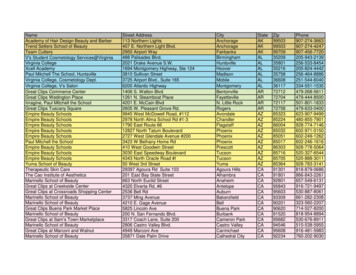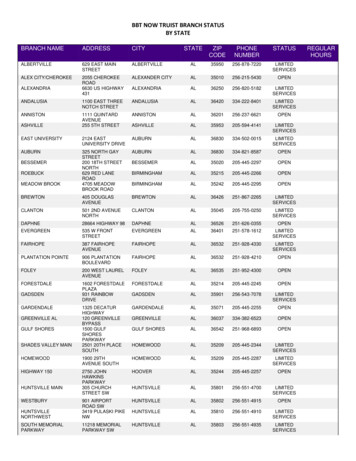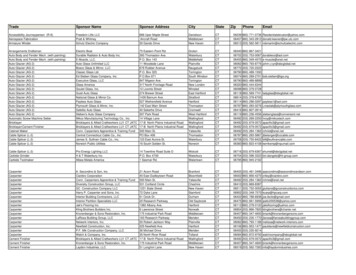
Transcription
Running Head: NUR 492 WINDSHIELD SURVEYNUR 492 Windshield SurveyZip Code 11219 – Borough ParkJodiane Ashpole, Grethel Castillo-Gorvits, Bracha Golbert, Sara Levy,Nydia Llangari, Terrin Niles Joseph, Tanjina Nowshin, Karen WilmottLong Island University1
N492 WINDSHIELD SURVEY2DATE OF SURVEY: November 6, 2013COMMUNITY NAME AND LOCATION ASSIGNED IN CLINICAL: Zip code 11219 – Borough ParkPLACE: Borough Park, as acommunity, has manmade borders [seediagram to the right (Olson, Van Wye,Kerker, & Frieden, 2006)] withMaimonides Medical Center, locatedat 4802 Tenth Avenue, Brooklyn, NY 11219, serving as the main acute care health facility. Onthe whole, health care facilities, including a hospital, doctors, dentists, and even specialists, areall available within the borders of the Borough Park community, and all health facilities are allaccessible by car and public transportation, including subways and buses.I noted limited garden landscaping and very few animals while walking through thecommunity. The lack of space for landscaping lessens the threat of poisonous plant availabilityor soil to threaten children and animals with plant or soil borne disease. Similarly, I saw only afew stray cats, and no dogs or rats limiting the possibility of disease spread through animals.There are numerous private schools in, and surrounding, zip code 11219 but only a fewpublic schools. I found no reports of overcrowding in the public school system, though WorldMedia Group, LLC (2013) reports that the public school system in zip code 11219 is rankedabove average. All school buildings, private and public, appeared in good repair though, in someinstances, there was limited space for children to play outside. Public protection is evident withnumerous EMS services, including several volunteer ambulance services. One police precinct islocated in zip code 11219. The closest Fire Department is in Sunset Park.PEOPLE: At 4pm mostly women and children were on the street. Many of the women
N492 WINDSHIELD SURVEY3were dressed modestly and tastefully with long skirts, jackets, and hats. Many students in thestreets were wearing uniforms and backpacks. Near Maimonides many workers were leaving thehospital wearing scrubs. The few men that I encountered varied in appearance from suits withlong coats and hats to plain clothes or scrubs.The population observed was overwhelmingly white, with some Hispanic, AfricanAmerican, and Asian people were observed. The groups are residentially located with thehighest concentration of white, residents at the center of Borough Park and other groupsdispersed throughout the community with a concentration of non-white residents at the edges ofBorough Park. Racial and ethnic characteristics of the community are most evident atsynagogues and private schools, many of which depict the institution names in Hebrew orYiddish. On the fringes of Borough Park I saw one store with Chinese characters on the awning.I saw no churches during my walk through Borough Park. The Synagogues varied by groupsincluding Hassidic, Sephardic, and Ashkenazi Jewry.The World Media Group, LLC (2013) reports the “per capita income of 11219 Zip Codeis 12,678, which is much lower than the state average of 23,389 and is much lower than thenational average of 21,587;” however, the fancy stores, large homes, and luxury cars I sawindicate that some of the community members are very wealthy. This became more apparent as Imoved from the lower avenues and streets up to the higher avenues and streets of the community.Around Maimonides Medical Center I saw evidence of mental illness and disease, particularlywhen one gentleman on the street, who looked poorly kempt and disheveled, with a flat affect,started to suddenly yell at his cell phone. However, in general, once over one block away fromthe hospital I did not see any evidence of drugs, violence, disease or mental illness.ENVIRONMENT: There are no large industrial factories in Borough Park. Smaller
N492 WINDSHIELD SURVEY4industry that effects the environment mainly consisted of paint stores, photo developingcompanies, dry cleaners, and artisan stores such as monument and window stores. Thechemicals used in paint, photo, and dry cleaner stores can all effect workers and individualsliving the apartments above the stores. The roads are well marked but narrow and are notadequate to accommodate the high volume of traffic associated with the large population livingin Borough Park.HOUSING: The housing and architectural style of houses varies by section of theneighborhood. Multi-family homes and apartment buildings are most common. I saw no vacanthouses, very limited retail space, and no apartments being advertised for rent. The apartmentbuildings and homes can be quite old, with 90 years or older not being uncommon. However,new homes and apartment buildings can be seen sporadically creating a montage and varyingarray of architectural styles throughout the community. Most houses and apartment buildings arein good to excellent repair.SPACE USE: Land in Borough Park is mainly residential and commercial with no largeindustrial buildings and very limited public parks. Most space is private and there is almost noopen space, even on private residences.COMMON AREAS: The main “hangout” places appear to be yeshivas, the park, sidewalksoutside residences, and restaurants in the area, particularly pizza shops and ice cream stores.“Hangouts” may differ by socioeconomic status since eating out is expensive. Public areas suchas the park, sidewalks, and restaurants are open to strangers.TRANSPORTATION: Members of the community own cars, use public transportation, orwalk in order to get around, and in and out, of the community. The streets and roads are able tofacilitate transportation through the community, though due to the high density of the population
N492 WINDSHIELD SURVEY5and narrow streets congestion is common.SERVICE CENTERS: There are many community run social agencies and health facilities.However, there are limited recreation centers and after school activities. There are many officesfor doctors, dentists, and specialists, generally on the first floor or basements, of multi-familyresidences. I did not see any palmists or spiritualists.STORES: Many residents shop locally. There are a myriad of food shops, restaurants,home furnishing shops, clothing, music, toy, artisan shops, medical supply stores and specialtystores in the 11219 zip code area. Community members walk, drive, or take publictransportation to shop in the communitySTREET SENSE: The majority of people on the street were women, mothers, babies,children, and students. Near the hospital both men and women wearing scrubs or plainclotheswere exiting the hospital. All people were what you would expect to see on the streets at 4pm.People were dressed appropriately for the time of day and locations where I saw them. The onlyanimals I saw on the streets were a stray cat or two.COMMUNITY GROWTH: I come across a few remodeled homes or newly built apartmentbuildings. Street repairs were just completed in the month of September, and there were limitedpolitical posters. There was some garbage on the sidewalks, but otherwise I saw no abandonedcars, real estate signs, or abandoned houses. Many houses and buildings house stores on thebottom or basement floors.POLITICS AND MEDIA – COMMUNITY PERSONALITY: Few political campaign posterswere posted on houses or in store windows. Party affiliations were not readily apparent. Widelyavailable newspapers include Hamodia, Yated, and the Jewish Press. Magazines availableinclude Ami, Bina, Jewish Actions, and Binyan. Hebrew and Yiddish newspapers and magazines
N492 WINDSHIELD SURVEY6are also available. Print media is definitely the most important.Walking through Borough Park is a multisensory experience. The elevated subwaytrains, traffic, honking, and busses all make a lot of noise. Borough Park does not smell. Thehigher avenues and streets are much quieter and have more greenery which makes them looklovely and inviting. Borough Park has a nice feeling overall and parts make you feel like you arein a foreign city and culture. The community gave me a good feeling, with the higher avenuesand streets being most pleasant. This was mainly because the upper avenues and streets wereless crowded, and much cleaner, with higher end stores.HEALTHCARE STATISTICSBased on Take Care Borough Park,published by the New York Department of Healthand Mental Hygiene (NYCDHMH), the leadingcauses of premature death (meaning death thatoccurs before the age of 75) in the community ofBorough Park is cancer, ranking at 24%, and then heart disease ranking at 21%. “Other causes”equal 42% of deaths, which include accidents (5%), HIV-related deaths (3%), homicide (3%),suicide (2%), pneumonia and influenza (2%), and other (25%)(Olson, Van Wye, Kerker, &Frieden, 2006, p.4).These diseases, which and cause premature death, affect both males and females, mainlybetween the ages of 45-64. Cancer and heart disease are the two leading causes of death in bothsexes at the age of 65 and older (New York City Department of Health, 2002). The cancers mostprevalent in men, from the highest to the lowest, are lung, colorectal, and prostate. For women,breast, lung, and colorectal cancers are most prevalent. The category of ‘other’, constituting the
N492 WINDSHIELD SURVEY7majority of premature deaths in the community of Borough Park, is relevant to the elderlypopulation, those 65 years of age and older, and pertains to injuries sustained from falls and/orother accidents (Olson, Van Wye, Kerker, & Frieden, 2006, p.11).Cultural concerns for the Borough Park community, related to religious beliefs,sometimes prevent community members from fully utilizing the healthcare system. Similarly, alack of health literacy and knowledge of the healthcare system can be a barrier to care.Coalitions with community and religious leaders to improve health status maintenance, andincrease knowledge related to the leading causes of death and/or disease in the community, suchas addressing the need for maintaining a healthy heart and assessing and treating cancer throughearly detection and intervention, are imperative. Similarly, high blood pressure and highcholesterol, two of the greatest contributing factors to heart disease, need to be screened for andmaintenance programs established.The educational background of Borough Park residents is varied. The majority ofcommunity members have either graduated from high school (28%) or obtained some collegeeducation (42%) with 23% of residents aged 25 and older having completed a college degree.(Olson, Van Wye, Kerker, & Frieden, 2006, p.2).In 2006 it was reported that 15% of Borough Park residents were uninsured. Thisnumber is likely to change with the implementation of the Affordable Care Act. Insurance aside,only 4% of residents sought routine health care in the Emergency department in comparison to8% in New York City overall. In total, 20% of adults in the borough park population do not havea primary care provider which just about meets the TCNY target, indicating that Borough Parkresidents have better access to care, on average, in the community setting which leads to fewerED visits (Olson, Van Wye, Kerker, & Frieden, p.5).
N492 WINDSHIELD SURVEY8Screening, case finding, and teaching by nurses tend are focused on current health risksthat trouble the community. For example, fall hospitalizations in older adults were the highest inBorough Park among all areas of Brooklyn (1235 hospitalizations per 100,000 ppl), with the rateof hospitalizations 25% higher in Borough Park than in Brooklyn overall. Furthermore, 30% offall hospitalizations were for hip fractures (Olson, Van Wye, Kerker, & Frieden, 2006, p.14).Additionally, Borough Park adults are less likely to have HIV screening performed as evidencedby the fact that only 15% were tested in the past year, and 57% of individuals who reportedhaving sex with multiple partners reported not using condoms, which is 17% higher than theBrooklyn average and 19% higher than NYC (Olson, Van Wye, Kerker, & Frieden, 2006, p.8).Equally important, in 2008 the TCNY goal of immunization rates for influenza and pneumonia inadults older than 65 was more than 20% below the target of 80% (Olson, Van Wye, Kerker, &Frieden, 2006, p.12). Taking this into account, nurses must initiate case finding activities andthen provide appropriate patient education. For instance, once and older adult is identified asbeing at risk for falls, the nurse can teach the patient to reduce the chance of falls by exercisingregularly, reviewing medications with their doctors, attending an annual eye exam, and creating afall-proof home. Furthermore, older adults can lower their hip fracture risk by getting adequatecalcium and vitamin D from food or supplements, doing weight bearing exercise, gettingscreened and treated for osteoporosis ("Older Adult Falls Publications," 2013).There are various future needs which should be addressed in the Borough Parkcommunity. The number of hospitalizations due to falls, lack of insurance, low immunizationrates, and lack of HIV testing are all areas that require improvement.The primary care practitioners in Borough Park include physicians, physicians assistants,and nurse practitioners. A comprehensive list can be found by performing a Google search for
N492 WINDSHIELD SURVEY9primary care providers in zip code 11219. Access to PCPs influences family compliance withmedical regimes. For example, as noted previously, only 20% of adults in the borough parkpopulation do not have a primary care provider, which is just about meeting the TCNY goals,and only 4% of residents go to the ED when they are sick. This indicates an above averageprevention of avoidable hospitalizations with Borough Park ranking 7th out of 42 NYCneighborhoods (Olson, Van Wye, Kerker, & Frieden, 2006, p.5). Late maternal prenatal care hasdecreased by 25% (Olson, Van Wye, Kerker, & Frieden, 2006, p.13) by 2006 and the heartdisease rate in Borough Park has decreased by 15% (Olson, Van Wye, Kerker, & Frieden, 2006,p.6) between 1996 and 2006. These statistics seem to indicate an increase in family compliancewith medical regimes which has resulted in improved health status for the community.A community health nurse can reach out to the president, council members, andcommunity leaders of Borough Park in an effort to reach out to the community via meetings,seminars, and school presentation, which will facilitate community education and bring aboutawareness about major community issues. The need for more accessible health insurance andfree STD and HIV screening clinics, as well as increased health education needs to beimplemented. Similarly, the importance of regular doctor’s visits and health screenings shouldbe emphasized through community health initiatives. The elderly may be in need of serviceslike home health aides, assisted living, or tele-health technology.Utilizing communityresources and health initiatives would enable the neighborhood to be educated as well as beinvolved in disease management which will bring about positive changes.While there are many community concerns that the public health nurse can address, thefact that Borough Park suffers from the highest prevalence of falls in all of Brooklyn, is veryworrisome. Therefore, the nursing diagnosis that we chose to address is: Risk for falls R/T
N492 WINDSHIELD SURVEY10health problems, unsafe use of medications, and unsafe environment, AEB 1235 hospitalizationsper 100,000 ppl, with the rate of hospitalizations 25% higher in Borough Park than in Brooklynoverall (Olson, Van Wye, Kerker, & Frieden, 2006, p.14).CARE PLAN: This care plan was developed using “Gerontological Nursing” written byEliopolus (2010).Assessment: See Community Assessment.Nursing Diagnosis: See previous paragraph.Goal: Reduce falls leading to hip fractures and hospitalizations in Borough Park, Brooklyn at 1year and 5 years from date of implementation.Interventions: Create coalitions and pursue health promotion education with communityleaders to create health initiatives that teach fall prevention strategies. The following elementsshould be included: Create education programs and materials for older adults to make necessary changes inenvironment to improve home safety (i.e., remove throw rugs). Rational: These measuresprevent injury to patient. Provide adequate supervision to prevent injury to the patient. Teach patient with an unstable gait how to use assistive devices properly.Rational: Improper use of assistive devices can put the patient at greater risk of falling. Teach patient and family about the use of safe lighting. Advice patients to wearsunglasses to reduce glare. Encourage patients to wear prescribed eyeglasses, hearingaids and prosthetic devices. Rational: Proper lighting is always considered as apreventive measure. Teach patient to ask about medications that have been prescribed for him or her.Overmedication in older adults is one of the major risk factors in falls. Rational:
N492 WINDSHIELD SURVEY11Understanding on the part of the patient and family can reduce the incidence of falls inthe home. Enable social service/case manager to make a home visit to help improve the homeenvironment for the patient’s safety. Refer patient and family to community resourcesthat may offer assistance to the patient when needed.Evaluation: The care plan and intervention is considered successful if the communityhospitalization rate due to falls decreases at the 1 year and 5 year benchmarks.WHO INITIATIVE HEALTHY CITIES ELEMENTSIn conclusion, the community assessment indicates that Borough Park meets most of theWHO Initiative Healthy Cities Elements. The community has a high quality physicalenvironment, and a stable and sustainable ecosystem. The community is strong, non-exploitive,mutually supportive, and meets basic needs for water, food, shelter, and safe work environmentsfor the population. The population is involved in health initiatives, as indicated by dropping riskfactor statistics, and the majority of the community has access to a variety of healthcare services,with good communication and positive interactions. The economy is diverse, innovative, vital,and self-contained. Furthermore, the city is connected to its past, and the current structure iscongruent with and enhances the elements above. The community has a good overall healthrating, and while not perfect, appropriate public health and healthcare is accessible to the entirepopulation. Continued improvement and increased participation in health initiatives, improvedcleanliness, increased income, community safety, and continued access to healthcare are all longterm elements that should continue to be addressed.
N492 WINDSHIELD SURVEY12ReferencesEliopoulos, C. (2010). Gerontological nursing (7th ed.). Philadelphia, PA: Wolters KluwerHealth/Lippincott Williams & Wilkins.New York City Department of Health. (2002, June). New York City Neighborhood HealthProfiles: Brooklyn, 2000 (Rep.). Retrieved November 11, 2013, from The City of NewYork website: 0nhp-brooklyn.pdfNew York City Department of Health and Mental Hygiene. (2006). 2006 New York CityCommunity Health Profiles. New York City Department of Health and Mental Hygiene.Retrieved November 4, 2013, from ofiles.shtmlOlder Adult Falls Publications. (2013, October 29). Centers for Disease Control and Prevention.Retrieved November 12, 2013, alls/index.htmlOlson, E. C., Van Wye, G., Kerker, B., & Frieden, T. R. (2006). Take Care Borough Park. NYCCommunity Health Profiles, Second Edition: Borough Park (42nd ed., Vol. 13, pp. 1-16,Rep.). Retrieved November 4, 2013, /2006chp-206.pdfPolice Department of t
Nov 06, 2013 · numerous EMS services, including several volunteer ambulance services. One police precinct is located in zip code 11219. The closest Fire Department is in Sunset Park. PEOPLE: At 4pm mostly women and children were on
